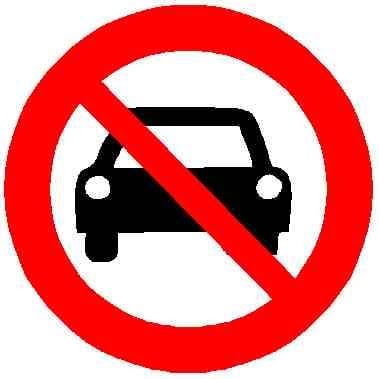Cars fulfill a very self-indulgent narrative. ‘I get to decide where and when I travel’, makes people feel “free” snd “important” even when millions of them are silently coming to the same decisions-- like going downtown at 09:00 on weekdsys-- that allow huge efficiency plays.
Notice how many ads feature fantasies of open roads and trips to faraway attractions, not the real world of “I need to sit in rush hour traffic from 6:30 on to get to the Work Factory”
Maybe public transit needs to focus its message on the freedom from drudgery it offers-- you don’t have to be staring at the driver in front of you, scanning the traffic reports
I dunno what country you are from, but here in the US of A, the monopolies that own all the train infrastructure make sure to keep trains as public transportation as cost prohibitive as possible.
This always reminds me of the movie, Roger Rabbit. I was a kid and the movie taught me a much deeper/darker lesson than it was meant to teach me at that age. It still irks me.
I used to watch roger rabbit as a kid for other reasons
I think I know exactly what you mean and I was in 3rd grade.
deleted by creator
Spoiler alert- the villain buys the transit system and shuts it down, basically steals a town it served, and plans to demolish the town so he can build a freeway over it and profit.
In case you need a hint, it was Doom’s plan.
Big Auto has been destroying any idea of high speed rails for decades. Our trains are complete trash because of car lobbyists.
Because as much as trains and buses are great for everyday commuter movement (and having amenities within walking distance is key as well), there’s two issues:
- Changing the infrastructure and zoning of an existing city is much easier said than done. Ripping up concrete, tearing down existing business and homes to increase densification, that’s a huge undertaking.
- Trains never replaced the horse drawn carriage. You can never fully eliminate the need for cars because sometimes you need to move something big like a couch. Even if there’s less cars on the road, it’ll never be 0, as this also includes things like ambulances, and fire trucks that can’t rely on schedules.
I would just settle for sidewalks, where I live in the USA it’s just streets with no sidewalks everywhere. I used to live one mile from where I worked and I could barely even bike there because of crazy car drivers and nowhere to go if someone wasn’t paying attention. Rural America is going to be car dependent for a long, long time.
I love trains
In Germany electric trains are standard for local public transportation.
Not everywhere. There are still enough lines that aren’t electrified so diesel locomotives have to be used.
That’s regional public transport, not local. I dare you to show me a city with diesel subway trains.
That is as local as it gets around here. We don’t have subways or street cars, it’s either busses (diesel) or train (motor coach actually) for even single digit km distances.
But yeah, it is real rail, not some separate local network.
But they are usually low frequency lines or in remote ish areas.
Uh, appparently only 61% of German train lines are electrified. I know of at least 2 heavily used lines that aren’t (so far). One is the connection Basel towards Bodensee, the Hochrheinbahn. Another is Ringzug.
The Bodensee one is getting electrified soon!
Website in german https://www.die-bodenseeguertelbahn.de/
Huh interesting, didn’t think it was that little. Thanks!
Trains only run on a specified track and there isn’t one near me. A car isn’t bound by a track and can go anywhere.
and there isn’t one near me.
That’s exactly the problem that this community wants to fix.
Trains could have intercity connections. Walk/bus to the train, ride the train, walk/bus to your destination.
I have metro+train and it already wears me out so much that alI arrive at the office tired. I can’t imagine how I would survive through 3 different transit options twice a day
I do the same and if anything, it just helps me wake up or wind down after a long day. Out of pure curiosity, how does it wear you out?
I don’t know, I could not even imagine the transit switch to be not overwhelming, it’s just way too many changes for me in a short span of time, like too many tasks. go down, wait for metro, try to not miss the stop, get up on escalator, go to platform, wait there, it’s just sucking out energy out of me, if I spent all that time just sitting on the train yes I unwind and I love it but dragging my laptop around and standing and waiting and having to concentrate instead of getting into the flow is disruptive for me. Plus I feel like underground is super dark and dirty and on the bus I get nauseous from so many braking and stopping and all the vibrating from the road
I’m sure you’re aware part of that anxiety can come from the unfamiliarity. I’m surprised it doesn’t end up being compared to the stress of merging from an on-ramp in a car, or watching crosswalks for pedestrians, or even just backing out of a driveway in some people’s cases.
100% anxiety from unfamiliarity. My last job had me flying over the US (terrible but it was for a renewable energy company and I was part of the Ops team). The first trip, I missed my flight, on which was my overnight bag.
But from that first flight, I knew exactly what to do, where to go, and when to do it.
If people take time to learn these systems over time, then these fears go away. Just takes courage to learn something new
Sure buddy, spend a few hours hopping public transport each day is so much fun.
Cars are superior in every single way, it’s paupers that cry out of jealousy we’re seeing here.
They know cars aren’t the problem, there are industries out there that spew out the equivalent of millions of cars but they don’t bitch about that.
hmmm, do I want to sit in a train, flip my laptop open and do some work, then walk through a park to the office for today… Or do I want to sit in traffic and do nothing…
Tough choice there
no, I absolutely do not want to work on my way to work
Work time starts when I open the laptop. I’m not volunteering that time, since i’m not completely insane. It makes a huge difference whether my workday starts in the office, or in the train.
unfortunately, where I work, worktime starts when I scan my keycard at the front door
Yeah, that’s not really an option then.
You’re right. It’s been raining all day today with a forecast of thunderstorms, I absolutely want to sit in a warm, dry box and not walk through the park :p
I’m gonna be real, I’d 100% rather sit in traffic. It’s somewhat relaxing to me.
I hate this trend that we need to be working all the time, even during our commute.
To each their own. I prefer 2 hours of working in the train and 6 in the office to traveling for 2 hours and working 8 hours in the office
To each their own. I prefer 2 hours of working in the train and 6 in the office to traveling for 2 hours and working 8 hours in the office
it’s paupers that cry out of jealousy we’re seeing here.
Found Andrew Tate’s account
Ugh, vegans.
Well trains can transport alot more people at once
Those industries don’t pump out their emissions in my city for me to breathe in, nor do they threaten to maim or kill me on a regular basis.
can go anywhere
As long as there’s road, no serious traffic, and fuel stations along with rest stops.
Thats not really true and you know it. Cars are like trains, limited mostly to paved roads that need to by built.
Are you seriously trying to tell OP that he’s lying about not living near a train? Or are you trying to say that the part about them running on a fixed track isn’t true? Either way, this is a really dumb take.
Also, you clearly haven’t been to rural areas, where dirt and gravel roads are common. Cars handle those just fine.
But those roads are far more numerous and further reaching than train tracks. Trains go from a to b. Cars can go which ever route you want. And you don’t build train tracks around a house.
Nope.
I have an electric car because I refuse to pay any more money to fossil fuel companies but still need to drive. I use public transport where possible, but many trips just aren’t viable.
It takes me 30 minutes to walk to the nearest shopping centre, but 2 hours to get there by public transport, or 5 minutes by car.
As an average citizen, I don’t have the means to build or fund new railway lines. I am, however, lucky enough to be able to refuse to drive fossil fueled vehicles and still survive.
Is biking not an option?
I have been using my bike for most short trips.
I’ve even ridden my bike into the city, then taken a train most of the way home when I realised I’m not as fit as I thought I was.I’ve actually solved most of my travel issues by staying home and deciding that I don’t actually need to travel. This works less well when the purpose of travel is to get food.
I doubt that a significant portion of the population lives somewhere that just trains and bikes could meet their requirements.
Around 60% of car trips in the U.S. are less than 6 miles. A plurality are under 3 miles, and IIRC, the average occupancy is 1.2 people. That indicates that bikes and walking could do just fine for a lot of people.
I doubt that. Only the US has weird population distribution.
Sounds like a classic example of poorly designed transit. Well designed transit is often faster than driving and should certainly be faster than walking unless your destination is not frequently visited by many people.
Can you point to any examples of “well designed transit”? In my head, I can only see transit being faster than a car if it’s in a densely populated city with small roads and dedicated transit lanes (be it a bus or a train). I don’t know if that describes most of the places people live in the US.
Many cities in europe have succesful transit systems that compete with car times. Amsterdam in the Netherlands is a strong example. As for the united states, some of the denser downtowns with metros will have faster commute times on their metros than by car. It is rare to find well designed transit in America and that is part of what this sub is advocating to change. Most of the existing decent transit in america is relying on whatever lines and zoning survived the mass adoption of the automobile.
Yeah but do you have any examples of good transportation outside of dense urban areas? I can’t imagine a typical American suburb being redesigned in any way that leads to efficient public transit unless maybe we push people into dense apartment complexes. And yeah, maybe that’s an option, but people aren’t going to give up their big houses and yards for the “privilege” of riding public transportation lol.
Don’t get me wrong, I do greatly dislike cars, and I think public transportation is a very good thing to have, but it’s not what’s going to save us from cars.
It works best alongside redevelopment. America is missing the in between of high density to low density zoning. Areas where building can be built 3-6 stories high and built to be flexible Where they can be mixed commercial uses or residential uses. This can create environments much easier to serve with public transit and walkability. This is basically how many older cities were before they started tearing themselves apart for the car.
You are correct in that public transit doesn’t service suburbia well. The car is the ideal solution to its design and thats exactly how it was built. After decades of this pattern and heavily subsidizing this development, the finnancial impacts are starting to catch up. Unfortunately when maintenance and repairs costs are considered, many suburban and strip mall developments cost more to maintain than the generate in taxes.
I live in a small city outside of Boston. We all know Boston has decent (for the US) transit, but consider my town …
-
we have two commuter rail stations for people commuting into Boston
-
train station in the center of town also
-
- bus hub
-
- taxi hub
-
- bike trail
-
- higher density housing
-
- “Main Street” with many shops and restaurants, all walkable
-
- most local government functions
So I am living in a single family home in a small city, but there’s a bus on the corner that will take me to the town center (or I could walk) where there are many destinations, many connections. A significant number of people already live there where everything is. Unfortunately I still use my car too often, but yes I think my town does transit well even though it is not a major city
-
Electric cars don’t solve a lot of the root problems of cars. They still require massive amounts of energy to move thousands of pounds of steel. They also still rely on sprawling roads and parking lots.
Absolutely. And the benefit trains have over cars is that you can reduce the amount of other stuff per person needed to get people moving.
For a local train of mine that seats 93 people with empty weight of 54 metric tons, that comes out to ~0.58 tons/person.
My sedan weighs in at about 1.5 metric tons empty, and since I’m the only one that uses it, my weight footprint is ~1.5 tons/person.
Forget about fuel economy too. Trains don’t have traffic (most of the time) to deal with, meaning they can accelerate to coasting speeds and spend most of the ride at best-efficiency. Cars are subject to traffic conditions, meaning efficiency can be as-designed by the manufacturer, or it can be much, much worse on a per trip basis if you contribute to the daily rush hours on freeways.
There is also much less friction on rails compared to rubber on roadways. If demand increases the length of the train can be increased or more trains added. This helps prevent the cycle of needing more lanes (rail lines in this case).
Electric motors are between 95 and 98% efficient, while ICEs are in the 80’s on a good day.
You are aware that electric trains also use electric motors, just like electric cars do, right? And you are aware that electric cars rely on an electric battery while electric trains rely primarily on overhead electric power lines, are you?
That means cars require one extra component and an extra conversation of energy which trains don’t need. Every conversation of energy reduces efficiency of the final outcome. The more conversations, the less efficiency.
Trains use: power lines -> electric motor
Cars use: power lines -> electric battery -> electric motorFurthermore, bigger machines can be built to be more efficient than smaller ones. So bigger motors can use (electric) fuel more efficiently than smaller motors.
That means cars require one extra component and an extra conversation of energy which trains don’t need.
Well, tbf, both trains and cars require converters (i.e. inverters like variable frequency drives or VFDs; or rectifiers) to match power between the local electric supply and traction motors, in the case of trains, or between the battery and traction motors, in the case of cars.
You need to be able to ramp up or down voltage or current (or both) depending on the drawing load that the motor sees at each and every moment of a trip (cars and trains). Then there is the possibility of your train jumping between different electric systems along its route, and so you need to have a way to accommodate those difference if you want to serve the most amount of passengers.
There are Battery Electric Multiple Units (BEMUs), too, out in the wild today that incorporate batteries in addition to electric service on trains (or just batteries alone), mostly in Japan and some in Europe. These are in the minority though compared to electric-supplied units.
Interestingly, there are some projects, most notably in Germany, where overhead lines are being introduced to trucks, fuzzying the differences in transportation modes even more.
I still get your point about the conversions, though. Batteries don’t have 100% Coulombic/Faraday efficiencies, meaning that they don’t charge up from 0-100% every charge cycle: you might start at 0-100%, but the next charge cycle might be 0-99.9999%, then 0-99.99%, then 0-99%, etc. This efficiency loss isn’t as great as the other losses you might find in the converters previously mentioned, or other resistive losses such as via Eddy currents in the motors/axles, demagnetization of the motors, etc.
Trains use: power lines -> electric motor Cars use: power lines -> electric battery -> electric motor
A better description of these processes would be:
Non-BEMU Trains: power lines -> converter -> electric motor (acceleration)
Non-BEMU Trains: electric motor -> converter -> power lines (deceleration)
Cars/BEMUs: power lines -> converter -> [battery -> converter -> electric motor] (charging [acceleration])
Cars/BEMUs: [electric motor -> converter -> battery] -> converter -> power lines ([deceleration] discharging)
Furthermore, bigger machines can be built to be more efficient than smaller ones. So bigger motors can use (electric) fuel more efficiently than smaller motors.
Totally. And trains that add batteries onboard can reduce the advantage that non-battery EMUs have, moreso resembling locomotives with big diesel engines and fuel tanks. I still find BEMUs better though because you can run the trains as married units, just like EMUs (and I suppose DMUs), but batteries can also be distributed along the rolling stock to allow for greater weight balancing. Idk if the major manufacturers like Siemens or General Electric have plans to design systems this way, but greater adoption may lead to more varied designs.
Hope this helps the discussion!
Well, tbf, both trains and cars require converters
Totally! My idea was that -> arrows represent the converters and to put it simply more arrows = more efficiency loss. But right, since power can also be injected back into the network, which is a good thing, there could be <-> arrows, or maybe <=> to better hightlight the bi-directionality:
power lines <=> electric motor
Since you mentioned putting power back into the grid:
I heard another potential use for car batteries would be using them to balance out local power fluctuations in the grid to make it more stable. Since cars stand still most of their life anyway, they might as well be connected to the grid whenever they’re parked. Not as a big energy reserve, since that wouldn’t be very efficient and capacity would be too low, but just to keep things more balanced which is a healthy thing for the power network. I suppose that also applies for train batteries.
Nissan has already started rolling out Vehicle-to-Grid (V2G) or Vehicle-to-X (V2X) chargers for its offering of vehicles since 2022, so it’s already happening.
Chris Nelder, who runs the Energy Transition Show podcast and who is a member of the Rocky Mountain Institute, published a paper even as far back as 2016 arguing how the potential for the US consumer rolling stock of BEVs (Battery Electric Vehicles; grid + batteries only) and PHEVs (Plug-in Hybrid Electric Vehicles; grid + batteries + gas) offering Demand Response services to utilities is enormous.
I’m not sure about the V2G compatibility of BEMUs feeding energy back to the grid to serve Demand Response is where the industry is going currently, instead favoring the implementation of overhead line islands as compared to extensive grid rollouts, but that reality is 100% feasible. The island approach I believe is also what Siemens is aiming for with the overhead-fed trucking solution I shared earlier.
Still exciting nonetheless!!!
Not to say trains are not more efficient than cars, because they are for a myriad of reasons. But electric motors scale relatively linear to my extent of knowledge, so usually it just ends up being that trains use many motors instead of one big motor.
Thanks for the info, I didn’t know how exactly this works, but I was aware that this factor is different for each device.
Thinking about it I guess that explains why small electric motor powered devices exist often while small combustion powered devices are rare? The only items I can come up with are forestry/gardening devices, tools for cooking and I guess lanterns. With the latter only using the heat/light and not actually moving anything.
I was responding to your assertion about EVs not being much better than ICEs.
I did not make any prior assertions. The post above was my first comment here.
To clarify, when you say ICE you are talking about trains, right? As in intercity express. And when you say EV you mean an electric car, correct?
I don’t understand why you argue that cars are more efficient than trains in this aspect. My argument is that since both machines use electric motors the motor efficiency can be nearly equal. Other factors probably favor a train more than a car if anything.
I don’t make a claim, but assume that even diesel locomotives might be a better choice than cars using only renewable energy, since the latter are idle most of the time, take up a lot of space, and require a lot of resources both in the car itself and in infrastructure. Surely something worht looking into.
energy is a non-issue
Because cars aren’t stuck to tracks.
And trains aren’t stuck to roads. And planes aren’t stuck to roads. And ships aren’t stuck to roads.
cars are stuck to roads and much less efficient everywhere many people need to go. cars are basically useful where only few people live or work.
I mean technically cars are only stuck to roads if you’re a law abiding citizen.
Roads allow for significantly more freedom of travel than trains because it would be cost prohibitive to build rail networks everywhere a car can reach.
Each mode of transport has its niche and one cannot replace the other.
If you can’t conveniently travel by train, that is a failure of the design of your city, not trains. If the destination a train took you to was walkable you wouldn’t need a car, because the train could cover the large distances, and you could simply walk from the train to your necessary locations.
“City”
This guy thinking everyone lives in urban centers.
Are they going to run a train to every remote village in Italy? Will everyone in Iceland travel to Reykjavik from their farms around the country by rail? Are we going to install rail on every island of Greece just so people don’t have to drive?
Sure, if we can build the infrastructure for cars there, why not trains too. You’re quite closed minded. But also, why can’t you just bike in a village? I mentioned cities because that’s where trains tend to be, genius.
There’s trams, there’s bikes, there’s buses, etc. etc. etc.
Sure, I’ll just bike through 4 feet of snow to get to town. Roads don’t need to fall within specific tolerances to operate either, like tracks. Have you ever been to the country? Anywhere that snows? You sound like “city folk” to me and you throwing around “closed minded” and “genius” when someone else brings up a contradictory point makes you sound more like “city asshole”. Maybe keep the conversation civil, eh?
There are several alternatives to trains. It was the appropriate example for cities. This is dead simple. If you’re gonna be a condescending, mocking asshole all while completely missing the point, you’re gonna get some sass. Simple as, fuck off if you can’t handle it.
Why can’t you just bike in a village?
It’s not about biking in a village. It’s about biking out of a village to a denser urban center. The place where the trains are.
You’re quite closed minded.
I think it’s closed minded to assume that trains and bikes can replace all utility of cars, or that cars will never be in a state where the impact on the environment is negligible.
there’s buses
That’s just a big fucking car.
Btw, I’m pretty sure places that are that remote rely on planes. Some parts of alaska are like that if I’m remembering correctly.
If the infrastructure exists for cars, it can exist for trains.
1 bus > 25 cars. Or how many ever it seats.
I agree yet most countries are determined to use cars, where public transport needs to be.
Did the car industry write this?
This isn’t a binary. We need both robust public transportation and electric cars (with an electric grid supplied by renewable energy). Public transportation can’t take you anywhere at anytime – it’s all a game of statistics and demand. If 12000 people want to go downtown at 7 pm, and 3 people want to go the opposite direction to get to work to start their night shift, you’re going to see buses and trains headed downtown but not the opposite side of town.
Public transportation is best served for commutes and travelling to popular areas, and that’s where the majority of emissions are coming from. Cars can supplement with everything else
Trains aren’t 100% the answer, but cars should be the last answer. Still we should electrify cars.
yeah, electricity should just be used everywhere.
most other energy types can be easily and efficiently converted to it, and it makes it easy to increase efficiency.
(power production and consumption are separated in electrical cars, so by making your power stations more efficient you make all of the cars that use them greener)Sadly most electricity production is via coal or gas. What’s needed primarily is to use less of those, for all reasons and uses. EVs just shift fossil consumption to where people don’t see it.
EV’s are so much more efficient that even running from electricity produced by coal, they are significantly better than ICE (internal combustion engine) cars. Just the electricity used to refine enough fuel to drive 100mi would be enough to drive an average EV more than 60mi. (This detail gets conveniently left out when comparing ICE cars to EVs).
We still need to decarbonise the grid, and as that happens, all electric cars (regardless of age) will become less polluting too. Having an unclean grid is not an excuse to keep using ICE vehicles.
I didn’t consider that refining fuel takes energy too. Does the drilling and transport get factored in to that as well?
Thanks for sharing the info!
The numbers I’ve used are only for the refining of the fuel. This video by Mark Linthicum (hosted on the Fully Charged channel) gives an amazing amount of information on the topic.
I would love to have trains and not need a car. Unfortunately that’s still a decade away here in California.
I’m all in favour of trains. I only take the train to work, and it’s so convenient I even take my kids to the city via train, to entertainment or shopping. However, even though I live inside the capital city in a Western European country, the train we take is powered by diesel. The government has been talking about electrifying the track for years, and the current estimate is that it will take another decade or more to get it done. There’s a single electrified rail line in the entire country, and based on the electrification progress it will take several decades to electrify the rest (if ever). Based on this experience, I’d venture to say that electric cars are far easier to deploy than electrify train lines.












